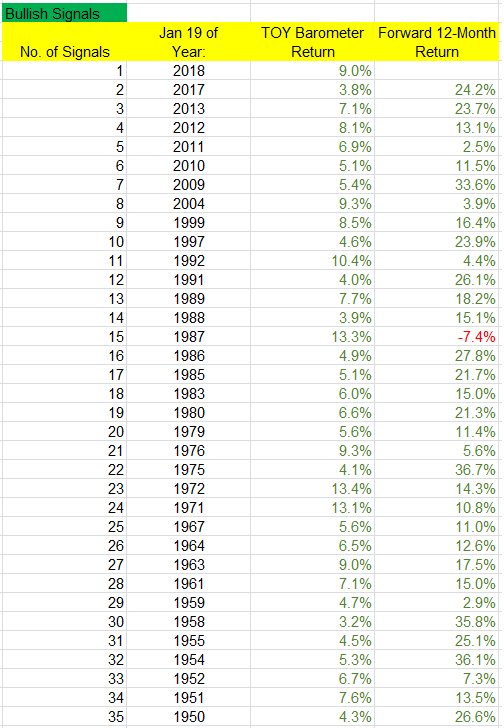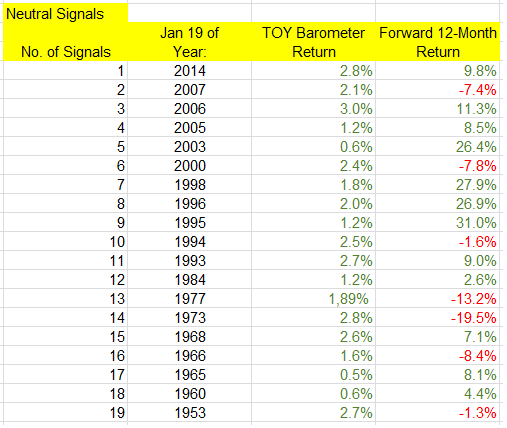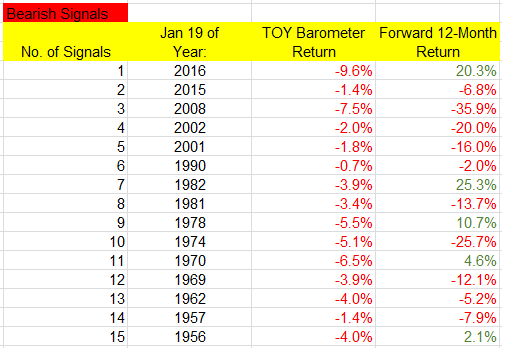Wayne Whaley’s TOY Barometer is possibly the single-best seasonal barometer. It uses the market’s performance between Nov 19 and Jan 20 to predict 12-month forward gains. It was brought to my attention by Steve Deppe (@SJD10304) and is worth discussing.
—————
Not a Leavitt Brothers subscriber but appreciate our work? Consider making a small donation.
—————
Mr. Whaley was a quant before quants existed. He has a background in math and has been managing money since the late 1980’s.
He considers the TOY Barometer to be the single most reliable seasonality barometer of forward stock market returns – so much so that he’s said if he could only make one trade/year based on one indicator, this is the indicator he’d use.
Whaley’s goal was to identify what he called the “kingpin of seasonal barometers.” He stated: “I implored my computer to take a few seconds to exhaustively study S&P performance over every time period of the year and determine which time frame’s behavior was proprietor of the highest correlation coefficient relative to the following year’s performance.”
What he found was there was a high correlation between the S&P 500’s returns between November 19th and the following January 19th and the S&P’s performance of the 12 months following January 19th. And since the 2-month period straddled the turn of the year (TOY) and gift giving season, he called it the TOY Barometer.
Specifically, the period studied is November 20 – January 19 (if Nov 20 is on a weekend, use the Monday after the weekend, and if Jan 19 is on a weekend, use the Friday before). He only considered the price-only return (no dividends).
If the return during this 2-month period was greater than 3%, a bullish signal was given, and the market was very likely to do well over the following 12 months. If the return was 0-3%, the signal was considered neutral, and results were somewhat random and in line with what is considered average. And if the return was negative, a bearish signal was given, and returns tended to be very poor.
Since 1950, there have been 34 bullish signals (not including the one that’s currently in place from the S&P’s close on January 19, 2018), 19 neutral signals and 15 negative signals. Let’s look at each signal group.
Bullish Signals
The 34 bullish signals have led to gains 33 times the following 12 months. The lone loss was 1987, the year of one of the biggest single-day crashes in history. The average and median gains of the 12 months that followed the signal were 17.0% and 15.1%. A 97% win rate with a 17% average gain is impressive. Here are the stats.

Neutral Signals
There have been 19 neutral signals. The following year was positive 12 times (63%) and negative 7 times (37%). The overall average and median returns were 6.0% and 7.1%. But among the “up” years, the average and median gains were 14.2% and 9.4%, but when “down”, the average and median losses were -8.5% and -7.8%. There were several big up years (1995, 1996, 1998, 2003), and two big down years (1973, 1977), so even if there is a neutral signal, there’s still a decent chance the following 12 months will venture far from its January 19 print. Here are the stats.

Bearish Signals
Of the 15 bearish signals, only 5 of the following years posted a gain while 10 posted losses. And 6 of those 10 posted double digit losses. The overall average and median returns were -5.5% and -6.8%. The “up” years posted average and median gains of 12.6% and 10.7%, while the “down” years posted average and median losses of -14.6% and -12.9%. Here are the stats.

Here’s a quick table summarizing the stats.
The bullish years are significantly better than “all” years while bearish years are, on average, much worse. Neutral years are slightly worse than “all” years.

We got a bullish signal in January of this year because between November 20, 2017 and January 19, 2018 the S&P gained 9.0%.
The S&P closed on January 19, 2018 at 2810.30, so unless this year is to join 1987 as only other year the signal failed, the S&P will have to rally ~ 140 points between now and January 19, 2019.
Last Monday, on November 19, the S&P closed at 2690.73. This is the level we have to watch for in two months on January 19.